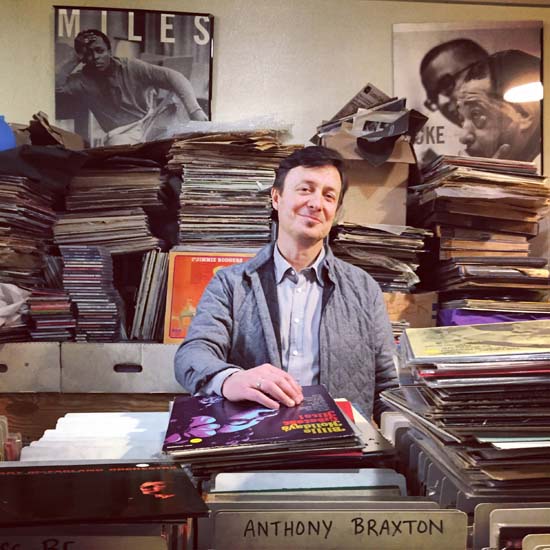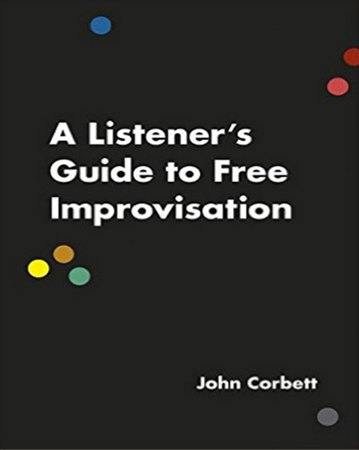Beyond Mystery & Mystique
Daniel Barbiero
October 2016
 Photo by by John Sparagana
Photo by by John Sparagana
Free Improvisation, Beyond Mystery & Mystique
John Corbett’s A Listener’s Guide to Free Improvisation
Although free improvisation is by now an established practice within musics of various types, decades of development haven’t taken away its capacity to provoke and puzzle listeners, particularly listeners new to its sounds and practices. John Corbett has been listening to free improvisation for years and beyond that, has organized shows, curated festivals, and even engineered recording sessions for the music. Now, with A Listener’s Guide to Free Improvisation, he has attempted to build a bridge to potential listeners by writing a kind of guide for the perplexed on how to listen to music that doesn’t follow the conventions of ordinary song.
1
For those unused to listening to it, free improvisation may seem a stubbornly opaque thing. Detecting the order concealed in its apparent chaos may seem the equivalent of deciphering the inner mystery of an esoteric tract. Much of this ostensible mystery derives from what free improvisation notably lacks. For as Corbett notes, most listeners bring to music expectations based on song structures of various sorts, most of which involve lyrics, a regular rhythm, cyclically recurring chords and verses, and so on. And it is here that free improvisation, in defying or ignoring the familiar conventions of song, can be so difficult. There are no cyclical forms of verse-chorus-verse to grasp; no regularly repeating sequences of chords; no predictable movement of tonic and dominant. How to make sense of it, then?
As Corbett shows, what’s needed is a set of listening skills different from those suited to conventional music. His book is thus largely concerned with sketching out, in friendly, unpretentious language, an alternate set of criteria that, like landmarks in an alien territory, can serve to guide listeners through unfamiliar sounds.
The criteria Corbett sets out help make the sounds intelligible and allow the listener not only to make connections between the sounds, but to understand the interplay among the improvisers as well. Many of his recommendations come down to good, common sense ways of learning to listen texturally–to listen for changes in density and dynamics, for shifts in the relationships between foreground and background voices, for timbral contrasts and similarities, for transition points and continuity, and for the undulations of rhythm liberated from the fetters of regular meter.
The advice he offers is practical and illuminating. Take, for example, the closely related qualities of rhythm and duration, which together contribute to the way time is experienced in music and which Corbett aptly identifies as presenting two of the biggest obstacles faced by newcomers to free improvisation. One reason rhythm and duration are so important for the musical experience of time is because in a very real, concrete sense, music exists in the future. When we listen to something, we anticipate where it’s going. Song cycles or regular rhythms create expectations of where the music is pointing and how long it will take to get there; without them, time seems to become trackless and the future indefinitely deferred. In such a situation, many listeners may become lost. But as Corbett suggests, there is a different way that listeners can experience time, one that finds movement in the absence of the aural yardstick of a steady regular meter. Instead, there are the cycles and epicycles that form and disperse in the overall flux of the performance as the musicians respond to the complex, complementary forces internal and external to them. Being able to hear this “wavelike activity”–as Ekkehard Jost is quoted as saying–can help a listener embrace the openness of the moment and go far to surmount what Corbett describes as a natural “anxiety about the ambiguous and the unresolved.”
2
Corbett is right to point to the experience of time as a key element in listening to free improvisation. All music exists in time and creates a sense of time’s movement forward, but free improvisation’s open structure colors this future as a very uncertain thing. In the absence of recurring harmonic cadences or cyclical rhythms, there is no obvious point of resolution or endpoint on which it necessarily converges. Instead, there is an emergent set of sounds and structures that aren’t realized until they’re produced by the improvisers’ concrete gestures, which are themselves the products of choices made in the flow of the improvisation. When freely improvised, the music’s future doesn’t happen in any perceptible way until it’s made. On top of this, in a live performance, there isn’t what Corbett elsewhere calls a “second pass”–a chance to hear something over again. As he observes, in this regard, the listener is somewhat on the same level as the improviser–both are in the moment, a moment opening out to a future that hangs on the choices the musicians must make in order to move the music forward into that future.
The musical situation the improvised performance reaches toward is undetermined and even to some extent unknown; not only is it not given ahead of time, but it is one whose form is as much made as appropriated by the moment-to-moment choices that both create and transcend it at one and the same time. Where existent musical forms offer the performer guardrails and a net underneath, free improvisation offers only a sense of risk and an unknown destination. From this sense of risk and openness, a certain mystique has grown up–the mystique of the free improviser’s crafting, through unconstrained choice, a performance of authentic, because free, self-expression. This mystique is something that Corbett in an interview has described in terms of “constant, total self-reinvention”–the notion that a free improviser shouldn’t fall back on repeating previous ideas and should, in effect, reinvent him- or herself ex nihilo with each improvised gesture. It’s a notion Corbett rejects–although he similarly rejects “needless self-repetition.”
The free improviser may not be subject to the external constraints of pre-existing musical forms and structures, but other constraints do come into play. Far from starting from an imagined zero point of absolute freedom, the improviser instead draws on a store of practical knowledge and skills–something similar to what Corbett refers to as the musician’s “lexicon,” or vocabulary–which provides the horizon within which his or her performance takes shape. The freedom of the free improviser, in other words, is a conditioned or constrained freedom in which choices are constituted within limits set by the artist’s history and competence. Consequently the improviser develops a repertoire of things he or she knows how to do when appropriately solicited by the situation, has certain formal and structural expectations of what shape the performance should take, listens and responds in ways that follow patterns formed by a history of practice and performance, and so forth. In short, the improviser works from a foundation of practical knowledge, much of it tacit and unreflected on at the moment it’s called upon during a performance. Corbett gets it exactly right when he characterizes the nature of the player’s engagement in free improvisation as consisting in “reflexes not contemplations”–what we might call the pre-reflective, intentional action of (apparently) instantaneous choice.
Corbett also is surely right to deny that free improvisation entails the constant reinvention of the improviser, and to affirm that repetition is a legitimate strategy in performance. If it’s true that the improviser’s choices are constrained by an internal sense of form, then it would be reasonable to suppose that certain formal features of a performance–phrase structures, timbral movements, pitch sequences, patterns of horizontal and vertical organization of sound generally–will be likely to recur, albeit in novel combinations in relation to themselves and to the choices made by others. In a sense, repetition just is the evidence of a voice: the individual voice of the improviser.
3
In the end, free improvisation is a praxis–a purposive action aimed toward some modification of the given. But it’s a special case in that the given to be modified isn’t given until it’s modified. This is just to say that the structures we hear unfolding before us are as much made as appropriated by the moment-to-moment decisions of the musicians who both create and transcend them at one and the same time.
The challenge of free improvisation, as of virtually any other kind of praxis, is to turn contingencies–those accidental and cultivated externalities that condition us and provide the horizon within which we live and undertake the projects that define us–into occasions of free choice. For the improviser, this choice hinges on decisions he or she must make in real time, decisions that reflect no more than a set of possibilities–not inevitabilities–from which he or she must choose at any given moment. Grounded in a specific set of skills and a personal history, the improviser is irreducibly free to choose responses within the complex, ongoing interplay of sounds and gestures of the unfolding improvisation, and for anything he or she does choose to play, the fact remains that he or she could always have played something else instead. Nothing is given in advance; the artistic risk is non-trivial.
As is the personal risk. Through our improvised choices of sounds, silences, phrases and other gestures, we disclose something about our way of being in the world. Each improvised gesture represents the result of a formal judgment that is our own and through which we reveal something of ourselves. With it, we disclose our sense of how things should be, how the situation this moment should be resolved in this particular way.
Corbett describes this existential dimension of free improvisation when he suggests that the best improvisers develop an intensely personal vocabulary–the “lexicon” alluded to earlier–of the sounds and gestures they find most meaningful. More than technique is involved, although that certainly is part of it; sensibility, and, as he terms it, “an amplification or intensification of personal identity” are also involved. In other words, something beyond music narrowly construed comes into play–something indicative of a more fundamental aspect of the improviser’s comportment in the world. When most effectively played, free improvisation tells us something about the improviser that goes beyond the strictly musical.
And so the mystery comes to explain the mystique. The key to the mystery of the order at the heart of free improvisation lies in the improviser’s praxis of applying his or her formal and technical sensibility to the composition of a work in real time. And this sensibility, embodied in sounds and gestures, just is the intelligible face of the expression that gives free improvisation its air of mystique.
The University of Chicago Press Books
Improvisation, Beyond Mystery & Mystique
John Corbett’s A Listener’s Guide to Free Improvisation
appears in the October/November 2016 issue of Perfect Sound Forever.
Both PSF and Daniel Barbiero have given us permission to repost it.
http://www.furious.com/perfect/johncorbett.html



Thank you for very useful précis of Corbett’s best ideas before expanding with your own riffs. Albert Murray said: the difference between riffing and shucking is – knowing the goddamn fundamentals.